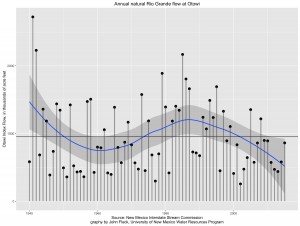The March 1 forecast for the Rio Grande in New Mexico suggests we are heading into another dry year on the Rio Grande in New Mexico, with a median forecast of 80 percent of the 1981-2010 average flowing into Elephant Butte Reservoir. (source pdf)
That is close enough to average that there is a lot of room on the wet side of the probability distribution to yet have a wet year. But when I wrote that last sentence I chose “average” rather than “normal” with some care, because “normal” for the years since 2000 has been dry. The graph to the right is what is called the “Otowi Index Flow”, a measure of native Rio Grande water flowing past Otowi, the key measurement point in northern New Mexico for Rio Grande Compact compliance calculation. The horizontal line is the long term mean, going back to 1940. You can see that just two years since 2000 have been above that mean. If the March forecast holds, 2016 will be the eighth consecutive year below that mean. One expects high variability on this system, with a big gap between wet years and dry years.*
But eight consecutive dry years would be extraordinary. The previous longest runs were four consecutive dry years. Since 2000 inclusive, flows on the Rio Grande at Otowi have average 30 percent less than the 1940-1999 average.
* In statspeak, the “coefficient of variation”, the size of the standard deviation relative to the mean, is 54 percent, which is big. By comparison the Colorado River at Lee’s Ferry has a coefficient of variation of 29 percent. The Mississippi at St. Louis is 34 percent.


Th terms ‘Natural Flow’ and ‘Native Rio Grande water’ seem a bit wrong to me since the Chama has both El Vado and Abiquiu dams mucking around with it’s flow into the Rio Grande above Otowi. Then there’s also Colorado River Basin water coming down through the Chama which is not ‘native’ . Maybe that’s being too picky for annual flow comparisons.
Cliff –
Sorry, I should have explained this. The “Otowi Index Flow” used in the graph is a calculated value that subtracts out the imported Colorado River Basin water.
You are correct, that it’s not “natural” in the sense that it doesn’t correct for interannual storage in El Vado and Abiquiu, but that doesn’t change the numbers all that much, plus this is the best we’ve got. On the Colorado, the Bureau does an exhaustive “natural flow” calculation at Lee’s Ferry to correct for all the upstream dams and diversions, but we don’t have anything like that on the Rio Grande, so this number is the best we’ve got.
Throw another bear in the canoe: “More extreme precipitation in the world’s dry and wet regions” Nature Climate Change http://www.nature.com/nclimate/journal/vaop/ncurrent/full/nclimate2941.html
See also “Global warming increases rain in world’s driest areas.” http://phys.org/news/2016-03-global-world-driest-areas.html “…Unfortunately for societies, businesses and agricultural activities that exist in arid regions, the expected increase in rainfall over dry areas does not necessarily mean that more water will become available according to the researchers. The additional heat caused by global warming will likely lead to increased evaporation. This means that while there may be more extreme flooding events it may have little impact on overall water storage rates.”
“The concern with an increased frequency and in particular intensity of extreme precipitation events in areas that are normally dry is that there may not be infrastructure in place to cope with extreme flooding events,” said Dr Donat.